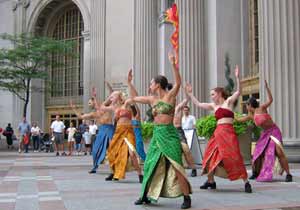
Delightful ‘A Midsummer Night’s Dream’ at Actors’ Summit
Seeing Shakespeare at American theatres, especially a theatre that doesn’t specialize in classical productions, can be a forbidding experience. Fear not. In general, Actors Summit’s ‘A MIDSUMMER NIGHT’S DREAM’ is a delightful experience.
Less is known about ‘A MIDSUMMER NIGHT’S DREAM’ than most of Shakespeare’s writings. Not only the date at which it was written, but why the play was scribed is up for discussion. It is assumed to have been developed between 1594 and 1596, early in Shakespeare’s life. It might have been written for an aristocratic wedding. Some Elizabethan scholars suggest it was written for the Queen to celebrate the feast day of St. John.
Also, in contrast to Shakespeare’s pattern for many of his other offerings, there is no known source for the play’s plot. One theory is that it is loosely based on “The Knight's Tale” from Chaucer's ‘CANTERBURY TALES.’
Though popular with viewers, most critics agree that the comedy is not one Shakespeare’s best plays.
The story features three interlocking plots, all of which are connected by marriage. Two couples, Hermia and Lysander and Helena and Demetrius, run away into the fairyland forest in order to avoid forced marriages, are pulled apart and then brought together through some shenanigans pulled off by the impish folk character Puck. The third couple, Oberon and Titania, the King and Queen of the Fairies, are also in a love/hate/love situation. Add a play within a play by a group of inept actors, and we have some wonderful light and joyous moments.
As one critic stated, “If ‘A MIDSUMMER NIGHT'S DREAM’ can be said to convey a message, it is that the creative imagination is in tune with the supernatural world and is best used to confer the blessings of nature upon mankind and marriage.”
Actors’ Summit’s production is filled with many very good and some mediocre acting. Kathleen Cutter is delightful as Hermia. Alicia Kahn lights up the stage as Helena. She has a wonderful sparkle in her voice and face which compels one to smile and empathize with her as she speaks. Andrew Narten (Lysander) and Noah Varness (Demetrius), are both fine and help complete the charming duet of lovers. A. Neil Thackaberry, as Theseus, and Sally Groth (Hippolyta) playfully create the mature couple. Though he sometimes knows no restraint, Peter Voinovich was the audience favorite as Bottom, the weaver who turns into a jackass.
Bob Parenti, playing the dual roles of Egeus, father of Hermia and Quince, a carpenter stumbled over a number of his lines and was often unbelievable. Puck needs to be impish, charming, delightful. Sasha Thackaberry was simply not “puckish” enough, often becoming slave to the poetic rhyming pattern.
Mary Jo Alexander’s costume designs were wonderful as was the creatively designed set.
Director A. Neil Thackaberry has shortened the play so that it runs two-hours, including intermission. No one, except a Shakespeare scholar, will realize that there have been cuts in the script. He has paced the show well and wisely has his actors using Shakespearean dialogue with General American pronunciation which results in ease of understanding.
Actors’ Summit received a large grant to perform matinees for area students. Over 1000 young people will be exposed to Shakespeare through this anonymous grant. It can only be hoped that the donor will see fit next year and for years to come to make money available to allow area students to experience the wonders of live theatre.
CAPSULE JUDGEMENT: Actors’ Summit’s ‘A MIDSUMMER NIGHTS DREAM’ is a delightful offering well worth seeing.














